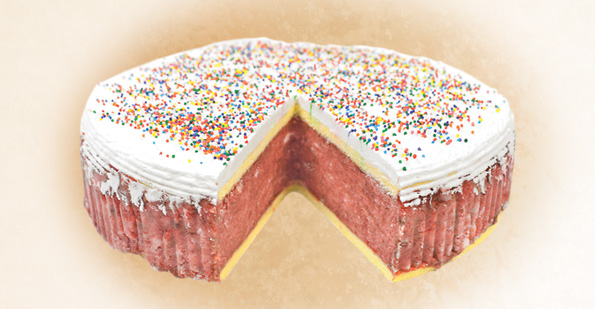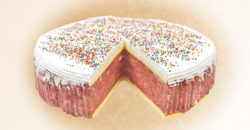Foodways
A Russian Enigma
Much of southern Louisiana and at least one other part of the world (no, not Russia) enjoy this unusual treat
Published: June 2, 2016
Last Updated: January 4, 2019

One often has to explain Russian cake these days, so I generally term it “the bread pudding of cakes” as a shorthand definition. David Haydel of the New Orleans area Haydel’s Bakery once referred to it as “the jambalaya of all cakes.” Neither term is precise because bakeries still making the delicacy stress that they no longer use stale ingredients; instead, trimmings from freshly baked sheet cakes are combined with refrigerated or frozen bits to create the Russian cake. When private cooks in elite New Orleans homes prepared the cake, they usually called it Creole trifle. As with many cherished, traditional delicacies, the origins of Russian cake are murky.
One popular theory holds that a New Orleans baker invented the dessert especially for the 1872 visit of Russian Grand Duke Alexis to New Orleans — the event that inspired the first Rex Carnival parade. The story does not hold up. Russian historian Lee Farrow, professor of history at Auburn University, just completed the first book-length study of Alexis’s tour of the United States, and she has found nothing to support that legend. Another explanation places the cake’s origins during World War II. It’s more likely a variation on one of a number of older desserts, such as the raspberry trifle, whose universality is indicated by its inclusion in the Joy of Cooking. Another antecedent is likely the punschtorte, a baked good popular in Austria and Germany in which the center of the cake is soaked in citrus punch and dark rum. The popular 18th and 19th-century molded dessert known as Charlotte à la Russe may also have influenced the Louisiana version, since its name translates as “Russian-style charlotte.”
The Charlotte Russe dishes described in Lafcadio Hearn’s 1885 La Cuisine Creole bear little resemblance to Russian cake, but one of the trifles included in his book calls for broken-up ladyfingers mixed with macaroons and a cup of wine. Several home recipes for Russian cake include ladyfingers and red wine in their lists of ingredients. A recipe for Parisian Charlotte Russe in the 1922 Picayune Creole Cookbook makes use of stale ladyfingers and macaroons.
What made the dessert “Russian”? Quite likely the name transferred from “Russian tea,” which in the late 1800s meant any drink containing rum (not vodka, surprisingly). Red wine and sherry are found in some of the tea and Russian cake recipes.
Newspaper mentions of Russian cake in the United States first appear not in Louisiana but in an 1898 Kansas newspaper as a recipe for home bakers who may be seeking desserts pleasing for kids. Russian cake first shows up in a New Orleans paper as a prize awarded at a fraternal organization’s meeting in 1913. The Charles A. Kaufman Co. department store on Dryades Street placed one of the first newspaper bakery ads in 1923. They featured several options for Thanksgiving Day dinner desserts, ranging in price from 30 to 90 cents; Russian cake sold for 30 cents, while mincemeat cost 40 cents. D.H. Holmes Restaurant and Bakery offered either iced vanilla, strawberry or almond versions of Russian cake in the mid-1920s.
My parents traditionally purchased the cake at Solari’s Market in the French Quarter until it closed in 1965. By the time I was born, the bakery at the Maison Blanche department store most often supplied our Russian cake, always a special treat. My first exposure remains a standout experience: while I eyed its mélange of colors, my parents warned me not to eat too much because it was very rich and contained rum. The technicolor combination of cakes held together with chunks of jelly and drenched in alcohol produced a vaguely bubblegum-like flavor.
These days, Russian cake devotees find it harder to track down their beloved dessert. Located in the Marigny neighborhood of New Orleans, Alois J. Binder Bakery sends french bread and sandwich loaves throughout town via their “Poor Boy Express” delivery trucks, but they also produce an excellent, traditional Russian cake. Mary Binder Walters continues to use homemade raspberry jam and real rum to yield a moist cake that can reconnect New Orleanians to their childhood memories. Haydel’s also makes a good version that anyone in the world can sample, thanks to their popular shipping business. Dottie Haydel mentions that one of their regular customers has Russian cake airlifted to France for his annual Bastille Day celebration.
Binder and Haydel’s emphasize that unlike the “lost bread” one transforms into bread pudding, the scraps they press into Russian cake are fresh or fresh frozen ones. Cubes of wedding and other dense cakes are combined with yellow and devil’s food cake bits and pressed into specially designed wooden molds.
Historically, bakers used a smooth white-pine box with a removable base, most likely lined with parchment paper to prevent the cake from adhering to the wood, according to Walters. Binder’s original box was 17 by 25 inches. Walters begins by baking a thin wedding cake layer for the bottom of her 16-by 12-inch pan. She breaks up sections of cake to form the first layer of filling, douses it in rum and spreads raspberry jelly along the top. She repeats this about 3 or 4 more times before finishing off with another solid wedding cake slab. Large bags of flour or sugar are placed on top to compress the cake overnight or longer in a refrigerator. Most bakeries present the final product topped with frosting and round rainbow-colored sprinkles.
Some bakers use anise extract in the recipe, but not Walters. Many bakers, including Haydel’s, use artificial rum flavoring; Binder uses white rum and dutifully informs every customer about its presence. People often bemoan today’s king cakes, sold with the baby outside the cake and a warning about not eating the plastic doll. A Russian cake rendered kid-friendly and edible for those who cannot ingest alcohol does not quite measure up to my nostalgic food memories. (And what about the 21st-century children who no longer feel the thrill of getting away with eating a rum-soaked cake?)
Another essential ingredient in the Binders’ product is their grandfather’s recipe for raspberry jelly. Since the Binders’ original bakery opened in the early 1900s, they have been renowned for their raspberry jelly donuts. Coupled with the traditional rum, this family separate Binder’s Russian cake from the rest.
By the early 1980s, fewer bakeries were offering the cake. For several weeks, people queried Times-Picayune food columnist Myriam Guidroz for a recipe. Unfamiliar with the term, Guidroz initially asked her readers to explain the cake. The recipe submitted by a woman from Lafayette seemed meant for a commercial bakery as it produced a 21-pound cake. It also demanded a bit of carpentry work before getting started: “I have a box my husband made large enough to hold half of an 18 x 12 inch baking pan. (The measurements of the box are approximately 10 inches wide by 14 inches long by 7 inches high.)” Wing nuts allowed the box to be disassembled when the cake was done.
As former mainstays of the baking business close and others drop the item from their list of offerings, the opportunities to enjoy Russian cake are dwindling. When a food blogger posted a photograph of his homemade Russian cake several years ago, a number of diasporic New Orleanians posted memories and expressed disappointment that bakeries in their new communities not only did not sell the confection but had never heard of the tradition. More surprisingly, a number of residents in the region of North East England also started to chime in regarding their individual quests for recipes and information about bakeries still producing this disappearing delicacy. Often termed Russian Slab Cake by Englanders, attempts to revisit childhood memories of Russian cake led to trans-Atlantic Googling. One reader bemoaned that the cake could not be found in North West England:
Thank you for solving a mystery. I was born in the n/east of England, uk, in 1946 and my mother regularly bought russian cake. I have lived in the n/westof england for 40 years and no one here has heard of it. my friends here say I am imagining it ! The cake we bought didn’t have any frosting or decoration on top. just the cake but it was definitely the same recipe. Delicious. —Elaine Abbot
Someone posted to the North East [England] Forum a detailed home recipe including all of the ingredients associated with New Orleans Russian cake; another person noted that a bakery chain sold them, causing the recipe poster to respond: “Yeah ya right! Forget that Bollox I wrote and go to Greggs instead.”
Both U.K. and the U.S. fans associate the cakes with the holiday season. New Orleans bakeries sell many more cakes during the holiday season, and some only produce it during November and December. Dottie Haydel says she must always bring one to a friend’s New Year’s Eve party.
How an English raspberry trifle or an Austrian torte transformed into a Russian cake and ended up on the endangered treats list in at least two parts of the Atlantic world remains an enigma. Those who want to make their own Russian cake may try out their carpentry skills or follow the recipe included in Rema and Richard Collins’ New Orleans Cookbook or the one Marcelle Bienvenu and Judy Walker presented in their post-Katrina Cooking Up a Storm: Recipes Lost and Found from The Times-Picayune of New Orleans. I say bollox to the woodworking and head straight to the closest Louisiana bakery that offers the cake or go online to order Haydel’s.
————————
Michael Mizell-Nelson, Ph.D., is an associate professor and public history program coordinator at the University of New Orleans.
(from LCV Winter 2012 Louisiana Foodways)
